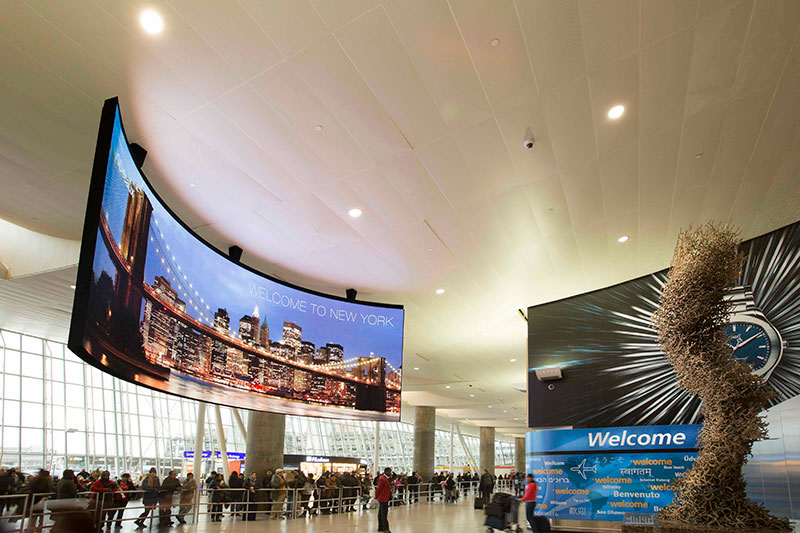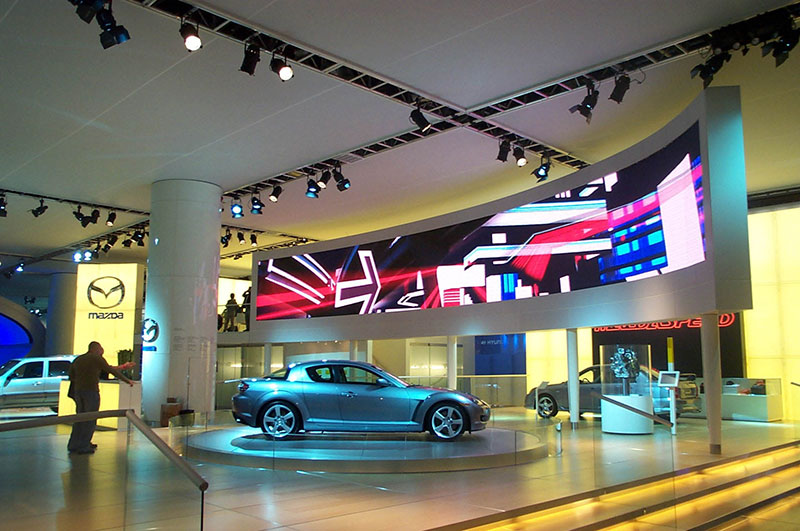How Much LED is Too Much LED?
Balancing creative design elements with content ensures a cohesive experience.
In an age of digital experiences, audiovisual technology is like an experience designer’s modeling clay. Applied and shaped by integrators, it can enhance spaces in a myriad of ways.
Direct-view LED technology has sparked the imagination of all types of space designers. LED — previously restricted to building facades, marquees, and Times Square — has come indoors. It’s less expensive than ever, and comes in finer pixel pitches so people can get closer to LED videowalls and still perceive the image or message.
“Basically, anything beyond a two-by-two or three-by-three videowall display will be replaced by LED pretty soon,” says Florian Rotberg, Managing Director of Invidis Consulting.
LED can be highly adaptable. The building blocks of an LED videowall — its tiles — are smaller than regular displays and can be reconfigured into shapes and sizes that create new and different visual experiences.
“It’s nice to do something beyond the standard 16:9 [aspect ratio],” Rotberg says. “With LED, you can break out of the usual 16:9 digital presentation with different shapes and aspect ratios, integrate it more with the architecture and interior design, and create new opportunities.”
Not to mention, today’s LED can be flexible. Designers can wrap it around columns or hang it from ceilings in wavy or circular formations — creating stunningly picturesque moments.
 Photo courtesy of Nanolumens
Photo courtesy of Nanolumens
“When you’re talking about Instagrammable moments driven by AV, people’s idea of what’s worth sharing moves way quicker than our technology,” says Paul Conder, Vice President for Guest Experience at CallisonRTKL.
“By the time you install a screen, that form factor is probably already spent,” Conder says. “So, it’s about what content you can put there, how flexible it can be, and whether or not you can move it around and create different experiences. If you look at the Nike store [in New York], their LED grid is formatted so they can move it around easily. It changes every couple of weeks, so they create a completely different experience in the space.”
What’s the Catch?
Everything that makes LED great can also be its potential downside. While dynamic, LED could easily be overused or used without regard for several important factors, not the least of which is the content it displays. “Lots of LED is tempting, and many will use it, but it can be very complicated from the content side,” says Rotberg.
“[A] customer was saying they wanted to be digital and modern,” he explains in reference to a recent retail project. “They wanted as much digital technology in their space as possible because they wanted to be the talk of the town. So, the architect started specifying digital all over the place. LED inside, outside, different aspect ratios, different resolutions.”
However, Rotberg explains, this type of setup requires significant overhead. In this case the client had to hire a specialized creative agency to adapt content to the various LED formats, and at one point the client was spending over $1 million a year on updating existing content.
When eyeing more custom installations, customers need to invest in adapting content to the various LED formats. At another retail space in the U.K., architects were tempted to include a variety of different LED elements, including eye-catching spirals handing from the ceiling. “But the brands couldn’t afford to adapt their content all the time, so some content would end up squeezed and distorted,” Rotberg says. “These days no one would accept their content being played out like that.”
In other situations, customers are forced to fit a round peg into a square hole. Some users of videowalls with non-traditional aspect ratios simply play traditional 16:9 content. “We see that quite often and it’s frustrating,” Rotberg says. “Clients spend a lot of money on LED and then they don’t really use 10, 15, 20 percent of it for the purpose it was intended for.”
When it comes to flexible LED installations, designers and customers need to remember that the very flexibility they crave may mean the message is incomplete — even if the content has been designed perfectly to match the display’s pixels. “Sometimes, because of the size and shape, there’s no one place where a person can stand and see the whole display,” Rotberg explains. “It looks great on paper and the client says, ‘Wow,’ but when it starts wrapping around a building or a column or some other architecture, it presents challenges for delivering a message.”
 Photo courtesy of Barco
Photo courtesy of Barco
Balancing Innovation With Impact
The best place to start is by considering the content and desired user experience early in the process.
“It sounds obvious, but in the case that the content is already completed, it’s best to start with the specifications of your content and let those drive your LED design choices,” says Sam Phenix, an AV tech executive and Secretary-Treasurer of the AVIXA™ Board.
“If content is not yet completed, then you are in luck and it frees up some room for creativity.” Phenix says. “Try considering the entire physical space as one canvas, that way you can build your story’s components in a way that’s consistent, resulting in a better experience for the consumer.”
When it comes to multiple different LED videowalls, a good rule of thumb is to design for just a handful of aspect ratios or form factors to keep things manageable. Good planning doesn’t preclude creative deployment of LED walls. It helps optimize the experience and ensure it lasts several years.
“We try to understand the viewer journey. Not only with regard to distance, but also how quickly are they moving? How wide is the space?” says Andrew Lazarow, Designer and AV Technologist for ESI Design. “We sometimes mix low-resolution and high-resolution LED based on different spatial relationships. We’ll do different resolutions of LED, but we’re very judicious when we spec different pixel pitches.”
Planning for LED Longevity
Including AV professionals at the beginning of any LED project, along with architects and designers, can help align goals and expectations. “Integrators understand the problem,” says Rotberg. “They know the challenges.”
While clients can purchase and deploy video technology, including LED, without the help of an integrator, technology firms like ESI Design work with clients, architects, and integrators to create videowall solutions that won’t grow old quickly.
At the 900 North Michigan Shops in Chicago, visitors need only look up to experience LED magic. Through a series of 10 LED canvasses along the mall’s ceiling, ESI Design created an ever-changing “sky” that generates ambience and allows the property’s operator to ensure the visuals automatically change and morph to promote retailers, products, and the city outside. “Even though it's 190 feet long and 10 high-resolution screens, we treat it as one cohesive canvas all the way across,” says Lazarow.
With planning, users can have the tools they need to maintain an LED installation, whether it’s a standard videowall or a creative, non-traditional display (or both).
“If it’s something that our clients are planning to use as an advertising canvas, we’ll be very up front and ask if we have the flexibility to make this visually unique or compelling, or is it important to keep it 16:9 so advertisers don’t have to make custom content,” says Lazarow.
In the end, the best way to take advantage of the compelling design possibilities of LED is to ask questions. And if the answers don’t add up, says Rotberg, the best solution may be “less LED.”
“Sometimes you have to be able to tell customers, ‘I think you may be overdoing it a bit,’” Rotberg insists. “Yes, AV companies would like to sell more LED, but at the end of the day, they like happier customers even more.”




